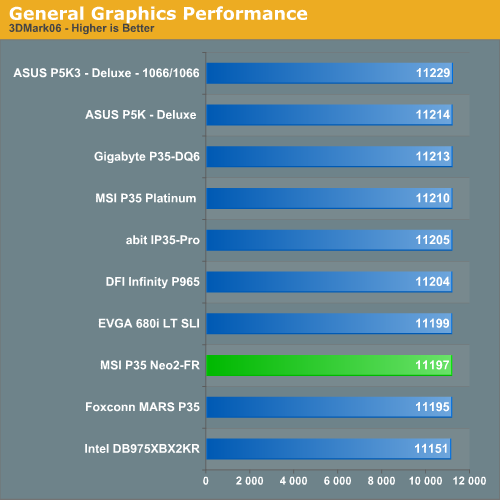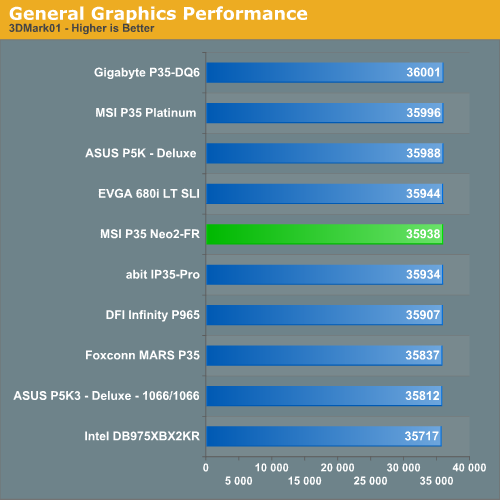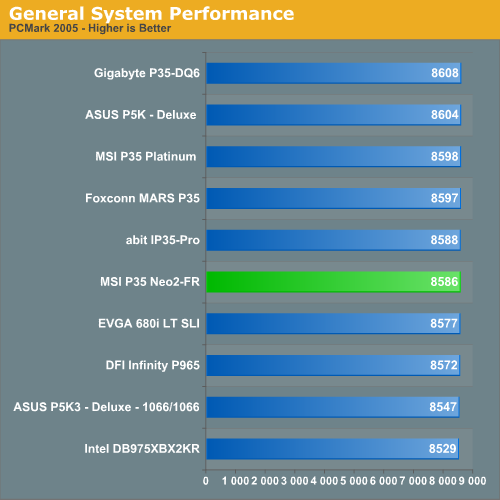MSI P35 Neo2-FR: Platinum performance for under $100
by Gary Key on December 5, 2007 11:00 PM EST- Posted in
- Motherboards
Synthetic Graphics Performance
The 3DMark series of benchmarks developed and provided by Futuremark are among the most widely used tools for benchmark reporting and comparisons. Although the benchmarks are very useful for providing apple to apple comparisons across a broad array of GPU and CPU configurations they are not a substitute for actual application and gaming benchmarks.


In our 3DMark06 test, all of the boards are within 1% of each other. When looking at the individual tests, the MSI board scores well in the CPU and SM2.0 sections and fourth from last in the SM3.0 tests.
In the more memory and CPU throughput sensitive 3DMark01 benchmark, we again see the spread between boards is less than 1%. The Neo2-FR board scores in the middle of the pack but is only 63 points from the lead even with a slight handicap in memory settings.
General System Performance
The PCMark05 benchmark developed and provided by Futuremark measures overall system performance for the typical home computing user. This tool provides both system and component level benchmarking results utilizing subsets of real world applications or programs. This benchmark is still useful for providing comparative results, but PCMark Vantage will replace it in our next article.

Once again, all of the boards are within 1% of each other with the Neo2-FR board finishing in the middle of the test group. There's nothing interesting to report here, so let's move on.










35 Comments
View All Comments
DigitalFreak - Thursday, December 6, 2007 - link
I sincerely hope that the USB port block on the back is supported by more than just that tiny riser. That thing looks like it would break off if you looked at it funny.Griswold - Thursday, December 6, 2007 - link
Nothing to worry about, unless some clumsy fool or 8 year old child rams the USB plug in.superkdogg - Thursday, December 6, 2007 - link
Reading the introduction about the surprising performance of the new MSI board got my ears up, but then I read the article and it was more of the same.Every motherboard performs virtually the same these days at stock speeds. The only things that differentiate anything is overclocking/bios, reliability, layout, price, extra features (if you need them), and personal brand preference.
Motherboard 'reviews' could pretty much be replaced by a table that tells a consumer about those things above. Benchmarking showing that everything is +/- 2% from the median just eats up space.
j@cko - Thursday, December 6, 2007 - link
LOL. I totally agree with ya. Motherboard review nowadays is more about reliability and overclockability, I think.JarredWalton - Thursday, December 6, 2007 - link
The problem is, if we were to eliminate all of the benchmarking, how do we really know if a board is reliable? If you haven't noticed, 90% or something of the text on the benchmark pages is filler - the graphs pretty much say everything you need to know. Anyway, doing motherboard reviews can be a thankless endeavor, but we still think it's necessary. We're not quite at the "necessary evil" stage either. :)brian_riendeau - Thursday, December 6, 2007 - link
Its quite easy really to show the effectiveness of a mobo design without wasting 5 pages on graphs that show no difference between 10 models of motherboards.Test the motherboards in harsh environments. No one really cares if their board is 1% faster than another board, however they will care if their whole system crashes repeatedly if their AC goes out and the room temp gets up to 90F.
drebo - Thursday, December 6, 2007 - link
Death of the P35 Neo-F, one of the best mid-range boards ever made. For $85 you get a superb P35 board, but they're not making it anymore. Moving to this board, you lose Parallel and Serial ports, which for many general home users are very important.Intel doesn't make a P35 board with parallel or serial, and ASUS's P5K board is about $40 more expensive. I really wish a tier 1 manufacturer would come out with another good board. The last couple generations it's been MSI, with the P965 Neo3-F and then the P35 Neo-F. Looks as though there won't be a P35 Neo2-F, unfortunately. They're making a hybrid DDR2/DDR3 board instead, which neuters any kind of RAM upgrades for the end users because you can only use one or the other, not both, and neither in a dual-channel configuration.
Oh well. Maybe ASUS will drop the price of their P5K board.
Ratinator - Thursday, December 6, 2007 - link
[quote]Moving to this board, you lose Parallel and Serial ports, which for many general home users are very important. [/quote]Did you mean not very important?
drebo - Thursday, December 6, 2007 - link
No, I didn't. You'd be surprised how many people at home have serial mice they don't want to replace (old trackballs that they're too stubborn to get rid of) and parallel printers. A lot of people in the business world need them, too. They need parallel for printers and serial to run machines off of, or for their PDAs, or for other reasons.There needs to be a good midrange board that still supports these legacy devices, and with the P35 Neo-F going by the wayside, that board just doesn't exist anymore.
brian_riendeau - Thursday, December 6, 2007 - link
I am sorry to inform you of this, however not many people shopping for new motherboards for business or personal use care about serial and parallel ports. You just gotta let things go man... Anyone who really needs to use a legacy port can pickup USB port -> legacy port adapters for cheap if they really need to use old hardware. We have a whole department of people where I work still chained to serial devices, however they all have C2D and Quad core PCs now and just use USB adapters.